Physical Address
304 North Cardinal St.
Dorchester Center, MA 02124
Most shoulder surgeons recognize that many patients with rotator cuff tear have some shoulder stiffness preoperatively. In general, these patients are managed with a shoulder mobilization program before surgical treatment; however, the ideal treatment for rotator cuff tears with shoulder stiffness remains controversial. Recently, simultaneous early treatment of the stiffness with rotator cuff repair has become popular because of several studies stating that there was no difference in final outcome compared with delayed treatment of the rotator cuff repair.
Although there is some debate whether to do manipulation before the arthroscopic capsular release or just do capsular release, our experience shows that most gentle manipulation is not harmful just before arthroscopic surgery. However, on rare occasion one sees some avulsion of the anterior glenoid rim with the labrum. After complete capsular release, especially the anteroinferior capsule (called the inferior glenohumeral ligament [IGHL]), the rotator cuff repair is performed. Rotator cuff repair should be checked in two perspectives: the biceps long head pathology, and subscapularis tendon tear and posterosuperior tear. In this chapter, we discuss some different and crucial aspects of rotator cuff repair and our personal opinions on it.
Many patients with rotator cuff tears not only have pain but also have decreased range of motion (ROM) of the shoulder, which inhibits their function in daily life ( Fig. 28.1 ).
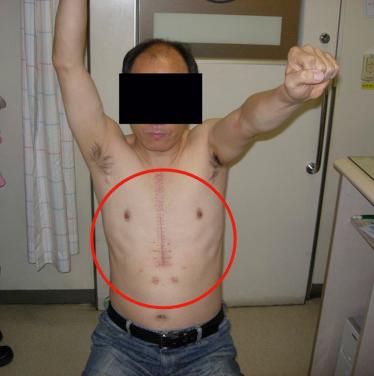
Pain, specifically sleep-disturbing night pain, frequently motivates the patient to seek medical advice. Most patients are comfortable with the arm at the side or with midrange activities but often describe a sudden, transient, excruciating pain with abrupt or end range of movements.
Usually, there are three different manifestations in patients with rotator cuff tears and stiff shoulder. First, a patient who has typical frozen shoulder with a partial rotator cuff tear has global limitation of ROM. Second, a patient who has a partial- or full-thickness rotator cuff tear has mild limitation of motion, generally meaning 25%–30% loss of total ROM compared with the opposite side. Third, a patient who has a full-thickness rotator cuff tear has global limitation of ROM just like a typical frozen shoulder. The third type of patient sometimes has a prior history of trauma that involved an acute rotator cuff tear extending the previous small to medium-sized chronic tear. These patients have an expanded tear toward the anterior (large subscapularis) or posterior (large infraspinatus and teres minor tears) segment of the cuff. The trauma is usually not major; it usually is caused by just falling down from a standing position with an outstretched hand.
Patients with advanced adhesive capsulitis may have lost the natural arm swing that occurs with walking. Moreover, muscle atrophy of the shoulder girdle may be present. As a result of impaired motion in the glenohumeral joint, abnormal scapular movement may be observed with active forward flexion of the affected shoulder.
A vague, diffuse tenderness over the anterior and posterior shoulder regions could be yielded by palpation. Some authors noted that in adhesive capsulitis, digital pressure on the area of the coracoid process elicits local pain (coracoid pain test) and could be considered as a pathognomonic sign of adhesive capsulitis. This could also be applied to patients with a stiff shoulder and rotator cuff tear.
Loss of motion with forward flexion, abduction, and external and internal rotation should raise suspicion for typical adhesive capsulitis. The amount of inflammation all over the capsule is depicted in Fig. 28.2 . With frozen shoulder, examination of the shoulder typically reveals significant limitation of both active and passive elevation, usually less than 120 degrees.

As described above regarding global limitation of ROM, when the patient has severe limitation of ROM, no physical examination is useful. All movement that stretches the capsule causes pain. Therefore the impingement test is usually useless. If the patient has mild terminal limitation of ROM, the impingement test result might be positive, and the results of the belly press, bear-hug, and lift-off tests, with the last of these a special test for subscapularis tendon tear, can be positive.
In this chapter, routine rotator cuff physical examination is not mentioned because it is dealt with in Ch. 5 .
Shoulder x-rays are done to rule out glenohumeral arthritis, calcific tendinitis, metastatic disease, or a greater tuberosity fracture that may cause global loss of ROM and severe pain.
Fig. 28.3 shows osteopenia compared with the contralateral side. One can see clearly the spurs and sclerosis of greater tuberosity (GT) and acromion, indicating severe impingement and partial- or full-thickness rotator cuff tear. Fig. 28.4 shows MRI findings of frozen shoulder which focus mainly on the inferior capsule pouch and thickness.
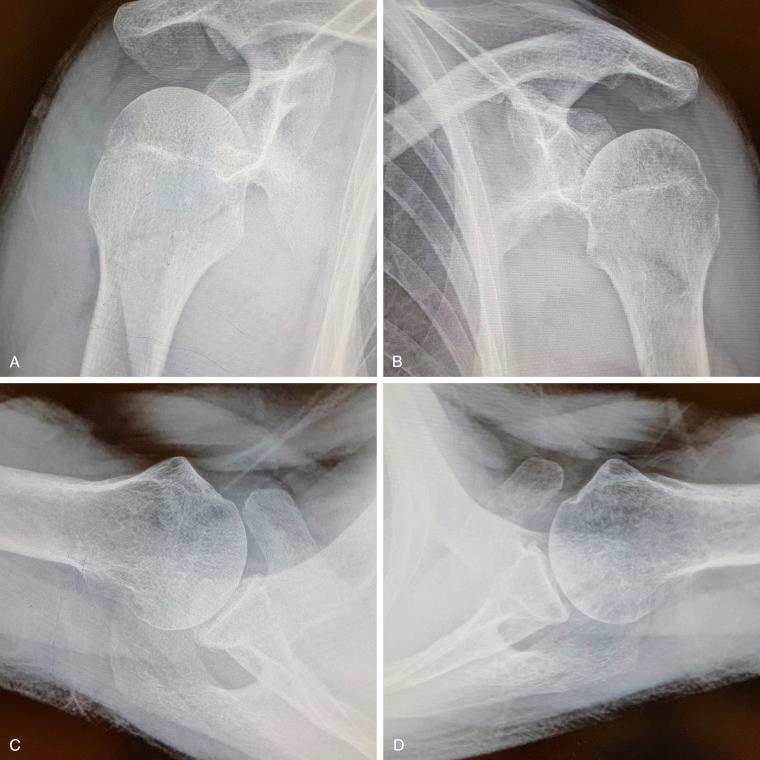
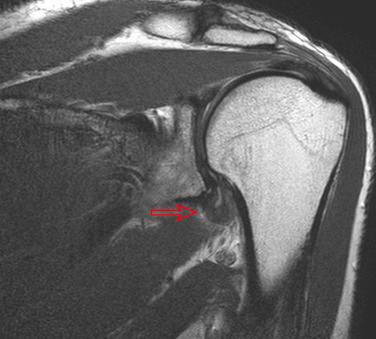
For nonoperative treatment, first give a steroid injection prior to rotator cuff surgery, which may relieve severe pain and global limitation of the shoulder to some extent.
The gentle manipulation can sometimes easily rupture the anterior/anteroinferior capsule ( Fig. 28.5 ). However, it can be skipped if the the capsule is too tight or if the stiffness and rotator cuff tear are caused by secondary stiffness, such as infection or fracture, and so forth. In such case capsular release is done during arthroscopic procedure ( Fig. 28.6 ), because it is too tight due to severe inflammation and chronicity ( Fig. 28.7 ).
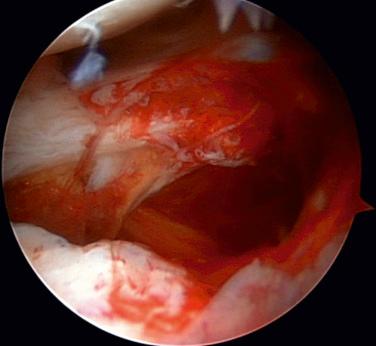
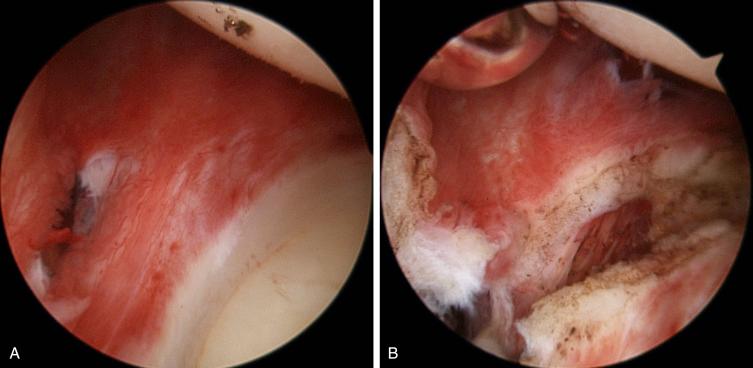
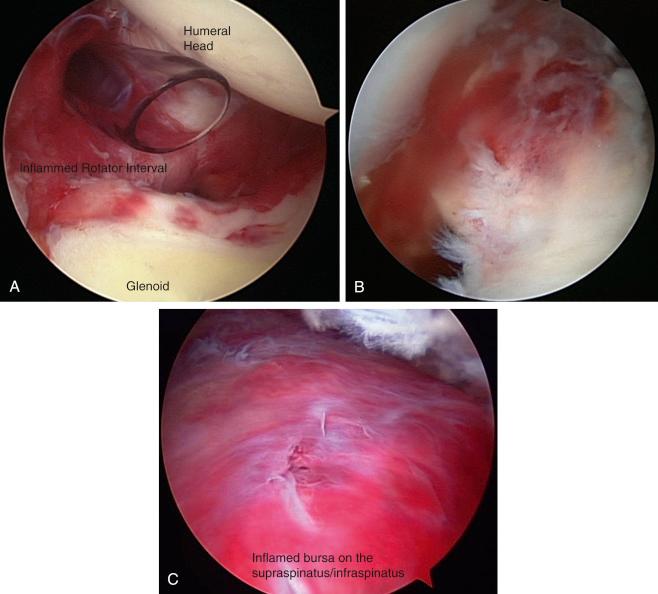
A contracture of the rotator interval, coracohumeral ligament, and inferior capsule might be seen, just as in patients with adhesive capsulitis ( Fig. 28.7A ,B).
The rotator interval tissue (including coracohumeral ligament, superior glenohumeral ligament).
Middle glenohumeral ligament: some are prominent, but some might even be absent.
IGHL: both anterior and posterior band should be severed.
Severe inflamed bursa and rotator cuff tendon ( Fig. 28.7C ).
Torn rotator cuff tendon.
There are still debates about whether to operate on those who have typical frozen shoulder and rotator cuff tear, especially with partial-thickness rotator cuff tear. Some argue that the frozen shoulder should be treated first, and the rotator cuff tear should be dealt with later, whereas others recently advocated otherwise.
Among the three general groups described below, the surgical indications may differ.
In those who have a partial tear with typical frozen shoulder, the frozen shoulder can be treated conservatively first. Afterward, the partial tear can be approached according to the same principle and indications for surgery without stiffness. This is generally considered persistent symptom and tear extending for more than 50% of its thickness. In partial tears, we feel that the frozen shoulder should be treated first, followed by observation to see if the partial tears progress to full thickness or have persistent symptoms; if so, surgical intervention is needed. It should be explained to the patient that the tear could progress even if pain and function improve after the frozen shoulder is treated. These patients usually attend your clinic for an opinion during the painful frozen shoulder period, which is the common reason they come for treatment, rather than because of the partial tear. Therefore the patient’s age should be taken into account, considering that partial tears progress very slowly; if the patient is very old, he can be observed without surgery. Unfortunately, however, these patients are generally in their 40s and 50s.
In patients who have full-thickness tears with moderate global terminal limitations, the surgical indication should be as same as full-thickness rotator cuff tear without stiffness. The capsular release should be focused on both bands of the IGHL.
Those who have typical frozen shoulder with full-thickness rotator cuff tears can have the same problem as those with partial-thickness rotator cuff tears. Currently in our practice, we do not delay the operation for frozen shoulder while waiting for it to improve; instead, we perform rotator cuff repair, capsular release, and rotator interval release at the same time. The rationale behind this is based on recent reports stating equally favorable results with concomitant procedures, as well as the fact that it takes more than 1 year to recover the frozen shoulder and another year is needed to recover the rotator cuff repair, so if one is going to be repaired, the other one might as well be repaired during the frozen shoulder period. However, in such a case, the surgeon and the patient should be aware of the possibility of a slower recovery and more pain. Also, acute-on-chronic tears with a definite trauma history is a sure indication for early surgical intervention. Those tears have a fresh retracted component, usually either subscapularis or infraspinatus tendon extension, with less muscle atrophy. They are easily mobilized with a sufficient tendon portion that can cover the original footprint. If these acute-on-chronic tears are delayed for surgery, they usually develop typical frozen shoulder stiffness.
Shoulder arthroscopy can be performed with the patient in the lateral decubitus position or in the beach chair position.
With the patient in lateral decubitus position, a U-shaped beanbag surgical positioner (Olympic Vac-Pac; Natus Medical Inc., San Carlos, CA) is placed on the operating table. With the patient positioned in the lateral decubitus position, the operative arm is placed in a position of 20–30 degrees of abduction and 20 degrees of forward flexion (Star Sleeve Traction System; Arthrex, Naples, FL). It is possible to obtain sufficient distension of the glenohumeral joint and subacromial space with this traction. Finally, in our practice, 8 to 10 lb of traction is applied ( Fig. 28.8 ).
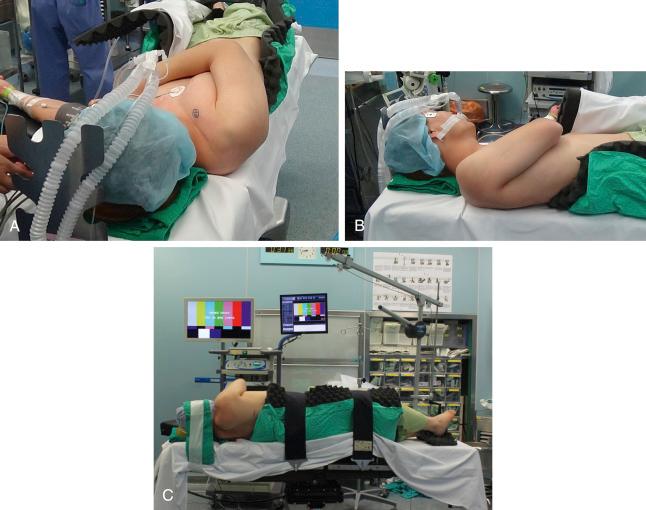
It is generally better to have the patient in lazy lateral decubitus position, meaning 30–40 degrees tilted up from the floor instead of the 30-degree posterior tilt from the lateral position. This is due to the fact that once the traction is in place, the patient tends to sit straighter laterally, making anterior portion access more difficult.
If the patient is rotated 30–40 degrees posteriorly to position the glenoid surface on a horizontal plane, there are some advantages: (1) less traction, decreasing the risk of neurapraxia of the brachial plexus; (2) accentuation of tears of the glenoid labrum because they are pulled away from their beds instead of in line with them; and (3) improved arthroscopic access to the inferior third of the glenoid labrum and capsule. It is easier to access the inferior capsule with lateral decubitus positioning.
There is a risk of compression injury to the contralateral brachial plexus. An antidecubitus gel pad needs to be placed between the operating table and the axilla. The bony protuberances of the contralateral elbow, hip, knee, and ankle are protected with the gel pad.
Placing the arm in 15-degree forward flexion is necessary because it reduces the risk of injury from traction of the brachial plexus.
If more than 2 hours of surgery is needed owing to difficulty in rotator cuff tears or inexperience in surgery, one might have to lower the traction weight, because the patient might still have some nerve symptoms resulting from the long duration of traction.
Become a Clinical Tree membership for Full access and enjoy Unlimited articles
If you are a member. Log in here